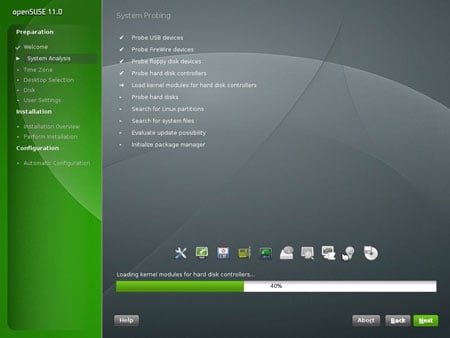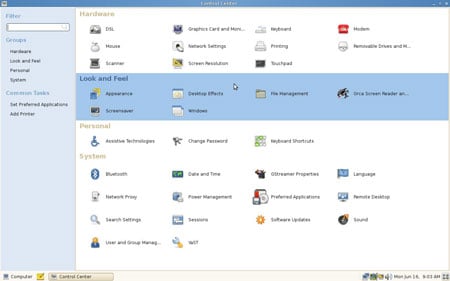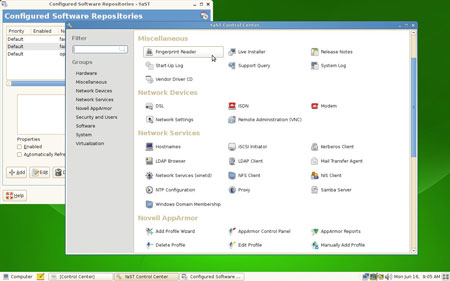Original URL: https://www.theregister.com/2008/06/18/open_suse_11_review/
OpenSUSE 11 a redemptive OS with a Mactastic shine
For newbies and Linux dark-lords
Posted in OSes, 18th June 2008 15:31 GMT
Review 2008 is proving to be a banner year for Linux distributions; so far we've seen Ubuntu 8.04 and Fedora 9, both of which go a long way toward making Linux painless for newbies.
You can now add OpenSUSE, the community-driven sequel to Novell's SUSE Linux distribution, to the list of significant releases. Version 11.0 of OpenSUSE is set to ship this week, ushering in a number of new features and solving most of the problems that saw OpenSUSE 10 get off to a bumpy start.
Many Linux purists will bristle at the mention of Novell since the company caved in and signed a patent protection agreement with Microsoft. Novell's business decisions, however, have little, if anything to do with OpenSUSE 11, and it's worth moving beyond the rhetoric to check out the new OpenSUSE release.
You're probably used to choosing your desktop - generally GNOME or KDE - before you download, but that isn't necessary with OpenSUSE since the live DVD takes an everything-and-the-kitchen-sink approach by including the GNOME, KDE and XFCE desktops as well as just about every package under the sun.
If you haven't got the bandwidth (or time) for the 4.5 GB DVD download, there are live CDs with either GNOME or KDE and somewhat fewer included packages.
Take that, Mac
The most noticeable thing when you start up OpenSUSE is the new installer which is just about the slickest setup app this side of Mac OS X. The easy-to-follow installer will walk you through everything with a level of handholding even Ubuntu can't match. Note that if you opt for the DVD installer you'll have the option to install all three desktops, while if you opt for the GNOME only distro you won't see the new installer.
On the KDE side you'll have the option to install either KDE 3.5 or the new, more experimental KDE 4. We did our testing on the release candidate build, which didn't offer the recently unveiled KDE 4.1 beta, though we've found the 4.1 beta to be more stable and useable than KDE 4.0.
Given that KDE is in something of a transitional phase we opted to install just the GNOME desktop.
Bespoke Gnome - Not Just a Band Name Anymore
Once OpenSUSE finished installing (around 30 minutes on our three-year-old Toshiba laptop) and rebooted, we were confronted with one of the most heavily customized versions of GNOME that you're likely to come across.
It might take seasoned GNOME vets a bit to work out what all OpenSUSE has done, but once you figure it out, the customizations are actually quite nice - for instance the somewhat scattered system configuration panels are all unified in one spot and there's a slick KDE-esque launch panel.
If you're a OpenSUSE 10 user, most of this will look familiar since the customized interface made its debut there (it's also part of SLED 10, Novell's corporate Linux desktop).
While there are OpenSUSE downloads with non-OSS software available (which include things like the Flash plugin, MP3 codecs, etc) installing such software from the normal installation isn't hard. Just point your favorite browser over to the OpenSUSE Community site and click the installer links.
And now to the major issues.
Zypper Woes - Also Not a Band Name
Among the potential gotchas for new users is the lack of readily available NVIDIA drivers. Ubuntu and others have made it relatively easy to grab non-free drivers from their default installs, and we were somewhat surprised to find that OpenSUSE skipped on what's become (for better or worse) a fairly common hardware driver solution.
The other problem we had was with the Zypper update utility. Zypper is new and reportedly features significant speed and stability improvements. In fact, early rave reviews about Zypper had us looking forward to testing OpenSUSE. For the command line junkies there's also a "zypper" utility which offers something very similar to yum on Fedora or apt-get in Ubuntu/Debian.
Unfortunately, in the release candidate we tested, Zypper wasn't working quite right. It would find packages that had available upgrades, but for some reason would never actually apply the updates. After a bit of digging we discovered that the issue is a known bug (and it's listed as a blocker in OpenSUSE's bug tracker), so it should be fixed by the final release.
While Zypper had a few pre-release quirks, the YaST panel was everything it's cracked up to be. When Linux users tout the customization options of the platform, they often forget that new users may find the number of options scattered and daunting.
That's where YaST comes in. YaST stands for Your awesome Setup Tool (Or the less inspiring Yet Another Setup Tool - Ed), and it is indeed quite awesome. YaST is by far the simplest way to navigate through the confusion of configuration panels, installing, theming and customizing to your heart's delight.
Also worth mentioning is that the kitchen-sink-DVD option of OpenSUSE includes VMware's openvmtools, which means that setting up VMware Player is a snap. Including the tools by default is a nice touch and will no doubt be appreciated by heavy virtual machine users, who have wrestled with VMware installs on various distros. Of course, if VirtualBox is more your bag, you'll have to set that up yourself.
Overall OpenSUSE 11 is a nice evolution in the SUSE line, building on the features in 10.3, but also making the distro more approachable for Linux newbies without withholding power user tools.
The DVD distro in particular offers just about all the options one could ask for and manages to make the installation process every bit as simple and elegant as a closed source system like Mac OS X, which is no small feat.
Provided the name Novell doesn't send you running for the free software hills, OpenSUSE 11 is an easy-to-use distro and worth a closer look. ®


